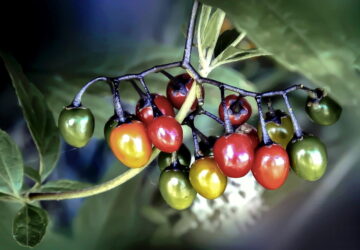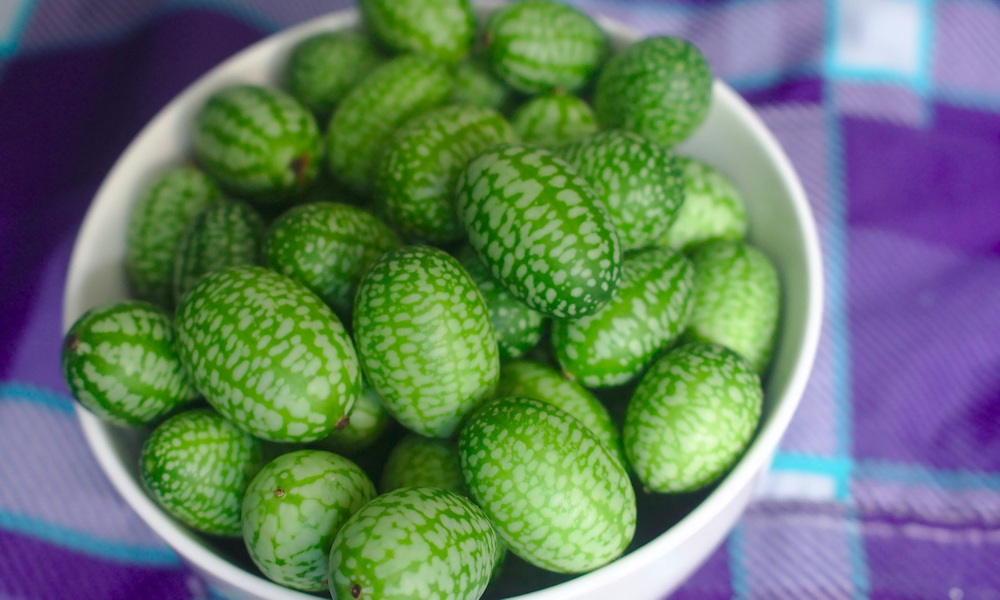Introducing the charming cucamelon, a unique and lesser-known addition to your garden. This article dives into the various aspects of this intriguing plant, from its origins to cultivation and culinary uses.
Unveiling the Various Names
Cucamelon, also known as “Mexican sour gherkin,” “Mexican sour cucumber,” “Mexican miniature watermelon,” “mouse melon,” and “sandíita” in Spanish, is a miniature cucumber-like fruit that has been gaining attention among gardeners and culinary enthusiasts alike.

A Jewel from Distant Shores
Originating from Central America, particularly Mexico and Guatemala, the cucamelon, or Melothria scabra, showcases its distinctive appearance with grape-sized fruits resembling tiny watermelons. The fruits possess a refreshing flavor, offering a delightful balance of cucumber freshness and a hint of tanginess. These adorable vine-climbers exhibit lush green foliage, making them an attractive addition to any garden.
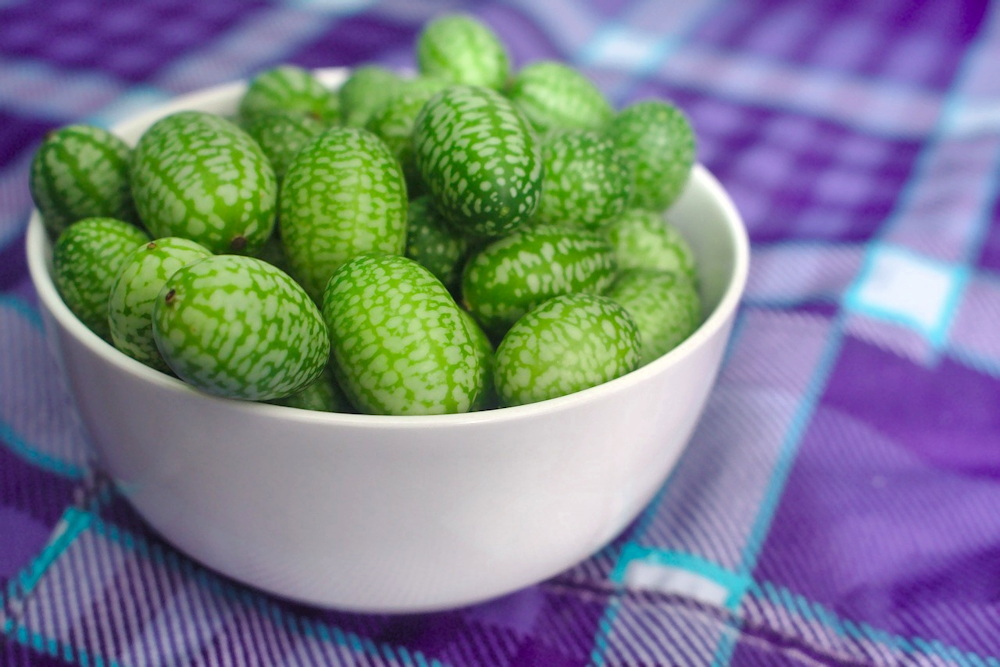
Culinary Adventures with Cucamelons: Exploring Their Kitchen Versatility
These tiny treasures offer a unique twist to your dishes, infusing delightful flavors and textures that spark inspiration. Here’s how you can make the most of their culinary potential:
- Sensational Salads: Elevate your salads by adding cucamelons for a refreshing crunch and a burst of tanginess. Their petite size makes them a charming addition to both leafy greens and grain-based salads.
- Pickled Pleasures: Embark on pickling escapades with cucamelons, turning them into zesty and crunchy delights. Quick-pickled cucamelons make for delectable snacks, sandwich toppings or cheese platter companions.
- Garnish Glamour: Transform your beverages into eye-catching refreshments by using cucamelons as stylish garnishes. From cocktails to mocktails, these miniature melon-like fruits add a touch of whimsy to your drinks.
- Savory Salsas: Give your salsas a unique edge by incorporating cucamelons. Their tangy flavor profile pairs exceptionally well with traditional salsa ingredients like tomatoes, onions and cilantro.
- Wholesome Snacking: Enjoy cucamelons on their own as a guilt-free and refreshing snack. Their crisp texture and balanced taste make them a convenient and healthy option for satisfying cravings.
Explore the endless possibilities that cucamelons bring to your kitchen. They are not only visually appealing but also a source of culinary inspiration, waiting to be savored in numerous ways.
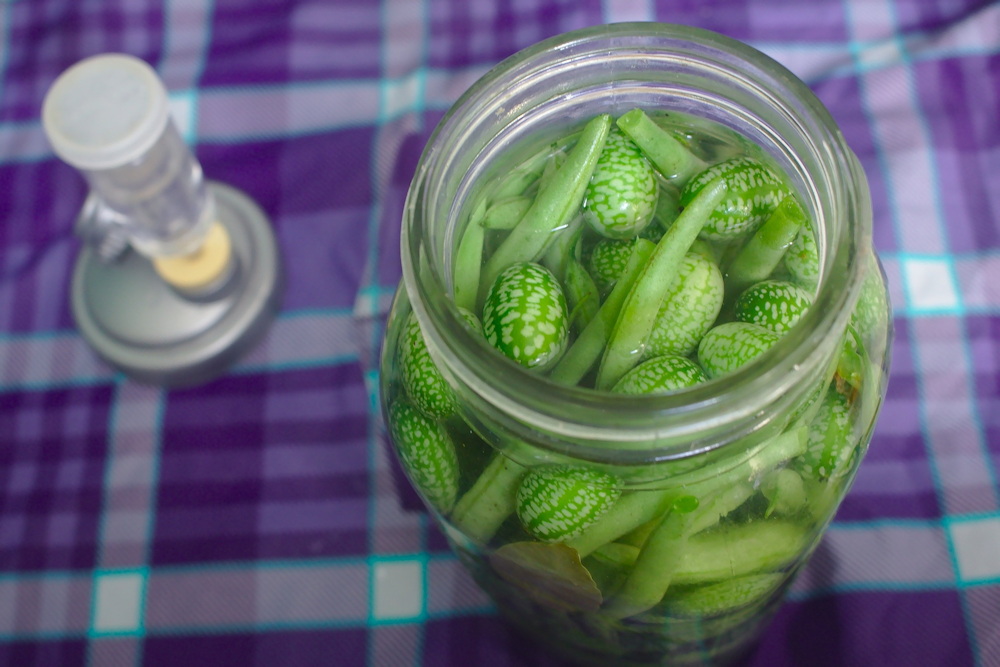
Recipe: Quick Pickled Cucamelons
For a quick and tangy treat, try pickling cucamelons. Begin by washing and sterilizing a glass jar. Pack the jar with cucamelons, a few cloves of garlic, fresh dill and a sprinkle of black peppercorns. Heat equal parts water and white vinegar in a saucepan, adding salt and sugar to taste. Pour the hot mixture over the cucamelons in the jar, seal it, and refrigerate for a day before enjoying these delectable pickles.
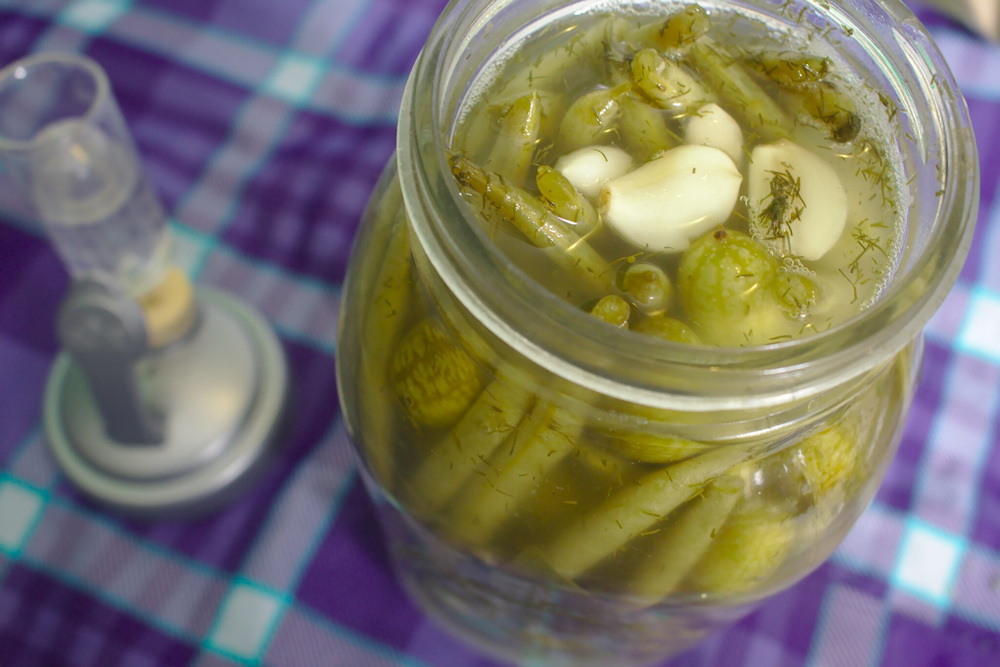
Nurturing Your Cucamelons: Garden Care Essentials
- Soil and Sunlight Harmony: Cucamelons thrive in well-draining soil that’s enriched with compost, ensuring a fertile foundation for their growth. Place them in a sunny spot where they can soak up ample sunlight, aiding their vigorous development.
- Planting Prowess: When planting cucamelon seeds or seedlings, ensure they’re at least 12 inches (30 cm) apart to grant each plant ample space for its sprawling growth. Choose a location with access to a trellis or support structure for the vines to climb, fostering healthy growth and facilitating harvesting.
- Tender Loving Care: Regularly inspect your cucamelon plants for signs of pests or diseases, although they generally exhibit natural resistance. Keep the garden clean to discourage potential problems and provide proper air circulation to the plants.
- Watering Wisdom: Maintain consistent soil moisture, as cucamelons benefit from evenly moist conditions. Water the plants at the base to avoid wetting the foliage, which can lead to fungal issues. During dry spells, be attentive to their hydration needs.
- Harvesting Happenings: Cucamelons are ready for harvest when they reach about the size of a grape or slightly larger. Gently twist or cut the fruit from the vine, being careful not to damage the plant. Regular harvesting encourages continued production.
- Seasonal Strategy: Recognize that cucamelons have a relatively short growing season. Plant them after the danger of frost has passed, and they will thrive in warm temperatures. Consider succession planting to extend your harvest period.
- Delightful Diversity: Embrace the unique nature of cucamelons and experiment with their flavors in various culinary creations. From snacks to pickles, these tiny fruits bring a refreshing twist to your dishes.
- The Ripple Effect: Integrating cucamelons into your garden fosters biodiversity and introduces fellow gardeners to the wonders of this lesser-known gem. By caring for these vines, you contribute to the preservation of unique plant varieties.
Fascinating Cucamelon Facts
- Cucamelons belong to the cucurbit family, just like cucumbers and melons.
- Their hardy nature makes them relatively resistant to pests and diseases.
- Cucamelon vines can reach up to 10 feet (3 m) in length.
- These tiny fruits are not genetically modified; they naturally resemble watermelons.
- Cucamelons have been consumed for centuries, tracing back to ancient Mesoamerican cultures.
Unleash Your Garden’s Potential
Beyond their culinary merits, cucamelons can be a gateway to exploring a world of unique and lesser-known plants. By incorporating such distinctive varieties into your garden, you contribute to the preservation of biodiversity and elevate your gardening expertise.
Concluding Note
Discovering cucamelons is like stumbling upon a hidden gem. These tiny, tangy delights promise a delightful adventure for gardeners and food enthusiasts, offering a remarkable blend of history, taste and visual appeal. Embrace the cucamelon’s charm and versatility, and let it weave its miniature magic into your gardening and culinary endeavors.

